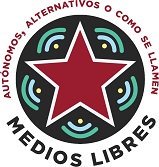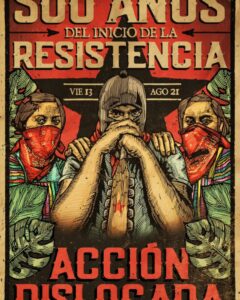
Subcomandante Insurgente Moisés: Thank you
Source: Enlace Zapatista
Dansk (Danés)
Deutsch Übersetzung (Alemán)
Tradução em portugês (Portugués)
Euskarazko Itzulpena (Euskera)
Traduzione Italiano (Italiano)
Original en español (Español)
Traduction en Français (Francés)
Slovenski prevod (Esloveno)
فارسی (Farsi)
Ελληνική μετάφραση (Griego)
Перевод на русский язык (Ruso)
Zapatista Sixth Commission
Coordinating Team for the Journey for Life: Europe Chapter
December 14, 2021
To the organizations, movements, groups, collectives, originary peoples and individuals from the different geographies of the land today known as “Slumil K’ajxemk’op”.[1]
From the Zapatista Extemporaneous [La Extemporánea][2] delegation:
Compañeras, compañeroas, compañeros:
Hermanoas, sisters, and brothers:
We send you warm greetings from the mountains of southeastern Mexico and can report that all of the compañeras and compañeros from the airborne delegation who visited you all in each of your geographies during the months of September, October, November, and December of 2021 have returned to their respective towns and positions.
As of 9:34 PM Zapatista time (8:34 PM Mexico time) on December 14, or 3:34 AM on December 15 Slumil K´ajxemk´op time, everyone had arrived at their respective villages, towns, and positions.
Each of us returned in one piece and in good health. We are all moved and touched by the days and nights that you allowed us to share with you, and we return with a life-long wound in our hearts which we will not allow to close.
It is now time for us to review our notes to inform our towns and communities of all that we learned and received from you: your histories, your struggles, your resistance, your indomitable existence, and above all, the embrace of humanity we felt from each of your hearts.
Everything we brought you came from our people. Everything we received from you is for our communities.
For all this–for your hospitality, your fellowship, your word, your listening, your gaze, your food and drink, your lodging, your company, your history and for the collective embrace from the heart that you are–we say:
(Continuar leyendo…)
THERE IS A WOMAN. Against the destruction of nature. Vienna, Austria
WORDS OF THE ZAPATISTA COMMUNITIES AT THE MARCH AGAINST THE DESTRUCTION OF NATURE
Vienna, Austria. In the voice of compañera Libertad, September 24, 2021.
Good afternoon.
These are our brief words in the form of a short story:
There is a woman.
The color of her skin does not matter, because she has all colors.
Her language does not matter, because she understands all languages.
Neither her race nor her culture matter, because all ways of being live in her.
Her size does not matter, because she is huge and nevertheless fits in one hand.
Every day and at all moments that woman is assaulted, beaten, wounded, raped, mocked and despised.
A male exerts his power over her.
Every day and every hour, she comes to us [nosotras, nosotros, nosotroas].
She shows us her wounds, her pain, her grief.
And we only give her words of consolation and pity.
Or we ignore her.
Perhaps as alms we give her something with which to treat her wounds.
But the man continues his violence.
We all know how this ends.
She will be murdered and with her death everything will die.
We can continue to give her only words of encouragement and medicine for her wounds.
Or we can tell her the truth: the only medicine that can cure her and heal her completely is for her to confront and destroy the one who is hurting her.
Knowing this, we too can unite with her and fight by her side.
We Zapatistas call that woman, “Mother Earth.”
As for the man who oppresses and humiliates her, give him whatever name, face, or shape you want.
We, the Zapatista peoples, call that murderous man capitalism.
And we have arrived at these geographies to ask, to ask of you:
Are we going to go on thinking that we can treat today’s blows with salve and painkillers, even though we know the wound will be bigger and deeper tomorrow?
Or are we going to fight alongside her?
We the Zapatista communities have decided to fight together with her and for her.
That is all we can say.
Thank you for listening to us.
Vienna, Austria, Europe, Planet Earth.
September 24, 2021.




